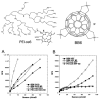Use of fluorescent probes for ROS to tease apart Type I and Type II photochemical pathways in photodynamic therapy
- PMID: 27374076
- PMCID: PMC5075498
- DOI: 10.1016/j.ymeth.2016.06.025
Use of fluorescent probes for ROS to tease apart Type I and Type II photochemical pathways in photodynamic therapy
Abstract
Photodynamic therapy involves the excitation of a non-toxic dye by harmless visible light to produce a long-lived triplet state that can interact with molecular oxygen to produce reactive oxygen species (ROS), which can damage biomolecules and kill cells. ROS produced by electron transfer (Type 1) include superoxide, hydrogen peroxide and hydroxyl radical (HO), while singlet oxygen (1O2) is produced by energy transfer. Diverse methods exist to distinguish between these two pathways, some of which are more specific or more sensitive than others. In this review we cover the use of two fluorescence probes: singlet oxygen sensor green (SOSG) detects 1O2; and 4-hydroxyphenyl-fluorescein (HPF) that detects HO. Interesting data was collected concerning the photochemical pathways of functionalized fullerenes compared to tetrapyrroles, stable synthetic bacteriochlorins with and without central metals, phenothiazinium dyes interacting with inorganic salts such as azide.
Keywords: Bacteriochlorins; Fullerenes; Hydroxyl radical; Hydroxyphenyl fluorescein; Phenothiazinium salts; Photodynamic therapy; Singlet oxygen; Singlet oxygen sensor green.
Copyright © 2016 Elsevier Inc. All rights reserved.
Figures






References
-
- Raab O. Uber die Wirkung fluoreszierender Stoffe auf Infusorien. Z Biol. 1900;39:524–546.
-
- Von Tappeiner H, Jodlbauer A. Uber Wirkung der photodynamischen (fluorieszierenden) Stoffe auf Protozoan und Enzyme. Dtsch Arch Klin Med. 1904;80:427–487.
-
- Lipson RL, Baldes EJ, Olsen AM. The use of a derivative of hematoporphyrin in tumor detection. J Natl Cancer Inst. 1961;26:1–11. - PubMed
-
- Diamond I, Granelli SG, McDonagh AF, Nielsen S, Wilson CB, Jaenicke R. Photodynamic therapy of malignant tumours. Lancet. 1972;2(7788):1175–7. - PubMed
-
- Dougherty TJ, Kaufman JE, Goldfarb A, Weishaupt KR, Boyle D, Mittleman A. Photoradiation therapy for the treatment of malignant tumors. Cancer Res. 1978;38(8):2628–35. - PubMed
Publication types
MeSH terms
Substances
Grants and funding
LinkOut - more resources
Full Text Sources
Other Literature Sources

